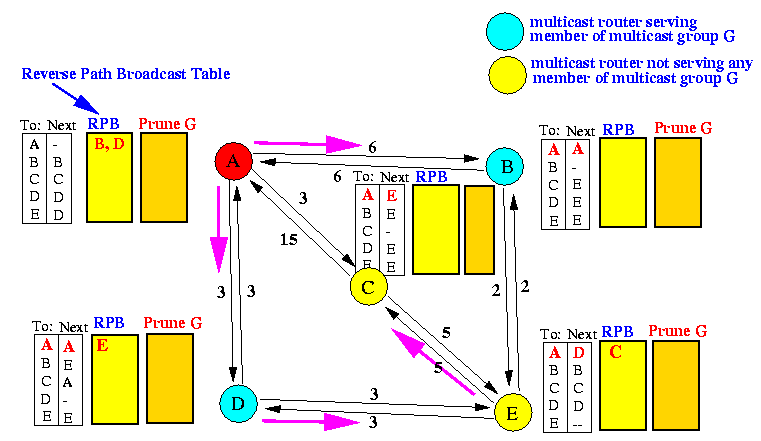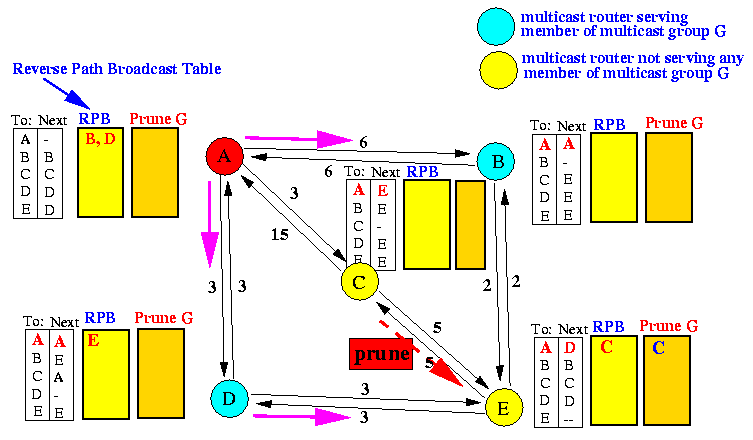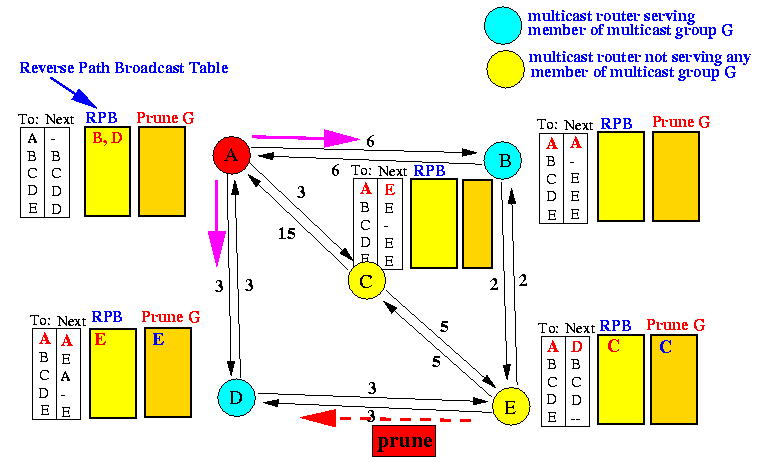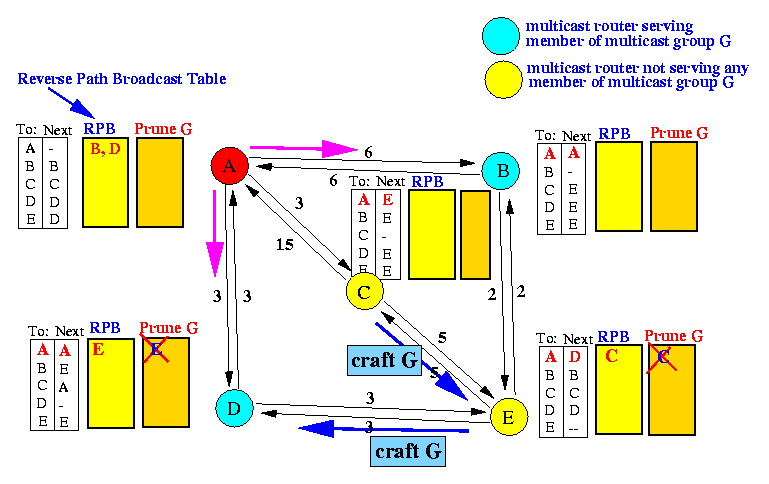- The Core Based Tree method was the
second
multicast routing method proposed for the Internet
- The first
multicast routing method for the Internet was
the
Distance Vector Multicast Routing Protocol
(DVMRP)
by Steve Deering in 1993.
It is probably still the most widely used multicast routing (although PIM - also by Steve Deering as a CISCO employee - is available, you have to pay big money for it, while DVMRP is free).
- DVMRP is based on
Reverse Path Broadcasting
The Reverse Path Broadcasting constructs a broadcast tree for every node in the network
We obviously do NOT want to send to ALL nodes
- In order to send a message to
a subset of (multicast) receivers ,
Steve Deering
added a feature to
prune off the branches
of the broadcast tree
that do not serve
any multicast members.
- It's very straightforward and I will illustrated the method with the follows set of figures.
- Recall that the RPB method constructs a
broadcast tree
for EVERY (source) node
The following figure depicts ONLY the tree rooted at A :

Other entries (rows) in the Broadcast Routing Table will store entries for the other broadcast trees.
- The DVMRP method adds a new
Prune Table
for EVERY every multicast group
Obviously, it will require to much memory - the Prune Tables are created when a multicast group exists
More specifically:
-
A router that
receives a multicast message for a group G
must create a prune table
for the multicast group G
So a prune table only exists when there is actual communication (packets) to the members of that group.
- The Prune Tables
contains a subset of
the list of nodes in the RPB table.
Nodes appearing in the Prune Tables are edges of the RPB tree that have been pruned away
-
The pruning away of edges will prevent
the "broadcast message" from reaching all nodes.
By pruning away the correct edges, the "broadcast message" will only reach nodes that have multicast receivers
- Example
- Nodes B and D are multicast receivers.
- Nodes C and E are NOT multicast receivers.
The following picture shows how the Prune Tables can prevent a "broadcast message" from A from reaching nodes C and E:

- Nodes B and D are multicast receivers.
- The question is: how do you get the correct prune entries ?
-
Simple, you tell your parent node to prune you away if all
your children nodes are not multicast receivers:
The following figure depicts a full tree with only one multicast receiver:

- At first, the leaf nodes sends
prune messages
to their parent nodes when they are not multicast receivers
- When all children of an internal node are prune, the internal node becomes a leaf node and will itself send a prune message to its parent if it is not a multicast receiver
- At first, the leaf nodes sends
prune messages
to their parent nodes when they are not multicast receivers
-
Suppose some hosts served by routers B and D
join multicast group G:

Notice that there is NO WAY for a source to find out who (which node) and where are the multicast receivers
This is also true for multicast sender served by node A
-
Now some host served by A
transmits a multicast message to group G:
The multicast message will be forwarded using the Reverse Path Broadcast table (with source = A) as follows:

Result of a multicast message from A:
- All routers receive the multicast to
multicast group G and will create a prune table
for G
- Initially, the prune table is empty (i.e., no links pruned).
- All routers receive the multicast to
multicast group G and will create a prune table
for G
- Now the pruning begins...
- The leaf router
C
does not serve any multicast member of G
- A router that is not interested in the multicast session sends a
Non-Membership Report (NMR)
to the upstream router, i.e., to the higher-level router
in the multicast tree
- The NMR report is also known as
a prune(G) message

- In response to the prune message, node E enters the sender ( C ) in its prune table for group G
- The leaf router
C
does not serve any multicast member of G
- The pruning continues...
- Now router E
has become
a leaf node in the multicast tree
(it can tell from the fact that the list of nodes in the prune table is equal to the list of nodes in the RPB table entry) - Therefore, router E
does not serve any multicast
receiver of group G.
- So router E
sends a
prune(G) message
to its upstream node D:

- In response to the prune message, node D enters the sender ( E ) in its prune table for group G
- Now router E
has become
a leaf node in the multicast tree
- The pruning ends:
- There are no further prune messages because all leaf routers serve
multicast receivers from group G.
- The resulting multicast tree will forward messages on a "pruned" reverse path broadcast tree.
- There are no further prune messages because all leaf routers serve
multicast receivers from group G.
In the example, I will use node A as the multicast source
This is the initial situation when there are no multicast receivers !!!
- If a host joins a multicast group and its router is
part of the multicast tree, then the join operation is easy.
- But if the router was
not part of the multicast tree ,
then the router may not have information on
the senders
of the multicast group.
Without knowning who the senders of the multicast group are, the router cannot know where to send "craft" message
- Let us handle the simple case first:
- Suppose some host served by node C
joins multicast group G, AND
- Node C knows that
A is a sender
of multicast group G.
- (This may happen if router caches multicast sender IDs)
Then C can send a "craft" message to its upstream node to A to "unprune" the link:

- Suppose some host served by node C
joins multicast group G, AND
- The most common case is where
node C does NOT know
that
A (or any othe node) is a sender
of multicast group G.
- DVMRP uses a
timeout mechanism
in the prune tables:
- The entries in the prune table
has a
time out value
- When the time out expires,
the entries in the prune table
are deleted
- This will RE-establish the
initial situation
- i.e.,
the tree used is the
Reverse Path Broadcast Tree
- The newly joined receivers
will now get the multicast messages
- The pruning operation
is restarted again, and prune away the
unnecessary branches.
- The branches serving the
newly joins receivers
will ofcourse
NOT pruned away !
- The entries in the prune table
has a
time out value